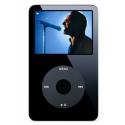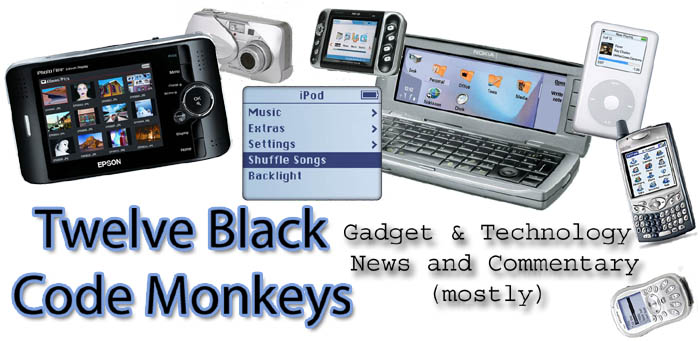| ||||||||||||
|
Converting video for the Video iPod
 There are many programs currently available that will convert video of various kinds to a format compatible with the video iPod. While none of these are prohibitive in cost, I didn’t feel like spending lots of time downloading trial versions to figure out which one might work best, nor did I feel like spending on one that a few people like only to discover there’s another that actually does a better job. Since the video iPod is so new, many software companies that make converters are just now modifying their products to include conversion options for the iPod. Maybe in a month or two the dust will have settled a little more and we’ll start seeing some in-depth reviews comparing some of these applications to one another. There are many programs currently available that will convert video of various kinds to a format compatible with the video iPod. While none of these are prohibitive in cost, I didn’t feel like spending lots of time downloading trial versions to figure out which one might work best, nor did I feel like spending on one that a few people like only to discover there’s another that actually does a better job. Since the video iPod is so new, many software companies that make converters are just now modifying their products to include conversion options for the iPod. Maybe in a month or two the dust will have settled a little more and we’ll start seeing some in-depth reviews comparing some of these applications to one another.In the mean time, as far as I’m aware, the only free program that’s been available is one from the same people who brought you PSP Video 9 (a video converter for the PSP) and Videora. The name of the program is “Videora iPod Converter” and it has a wide (and sometimes overwhelming for a newbie) assortment of settings one can manipulate for your conversions. Aside from the obvious ones like resolution and bit rate, there are others like Qscale, and conversion mode that are not nearly as well known. As with much freeware, there’s no real documentation available, nor is the program very straightforward to use. You need to create a profile for a given collection of settings, or use one of the programs presets. If you choose to use your own settings, you’re in no way guaranteed that they will work with the iPod. You may be able to get them into iTunes but they won’t transfer to the iPod if some setting is off.  Screenshot of Videora iPod Converter converting a file  Screenshot of Videora iPod Converter Profile Screen The two settings that this happens for most often is bitrate and resolution. The iPod will only handle resolutions that add up to 230,400 pixels - whatever the width and height dimensions are, multiplied they can’t add up to more than this number or the file won’t transfer. Similarly, for H.264 files, iTunes will not transfer it if it has a higher bit rate than 768Kbps – although at least in this latter case there is a hack to get around this, thanks to a user on the Videor iPod Converter board named DaProphecy. Apparently the chip in the iPod that plays video has the ability to play higher quality video than Apple lets on in their specifications. iTunes prevents you from transferring in this higher bitrate despite it being playable, so you basically have to trick iTunes into transferring the file. This, of course, is ridiculous and should not require a hack to get around. Hopefully Apple will update iTunes and make this a non-issue. Because of the massive numbers of settings, and no real clue as to which ones would work best in which cases, I determined to spend an inordinate amount of time transcoding a 55-second video clip into as many of these as made sense at the time. In all, I made 40 different conversions, although I’m sure I barely scratched the surface in terms of what I could have done. Still, I wanted to get a general sense of what each setting would do, how they would compare to each other in terms of the amount of time the conversion took, how big the file was, and what the quality of the video was both on the iPod and when exported out to a TV. I figured if I was going to convert my 200+ DVD library to video files for the iPod, that I should be fairly certain what settings to pick so that I don’t waste time converting to something which in the end wasn’t as efficient as another format in terms of time and storage space. I set about creating an Excel spreadsheet, linked here, which contains all my data, as well as my impressions of quality. The first sheet shows various conversions to H.264, whereas the second sheet displays results for conversions to MPEG4. Both of these are compatible with the iPod. To summarize my findings, much of it was predictable. Usually the higher the bit rate, the better the quality, although occasionally it was hard to tell the difference. When exported to TV, the higher the resolution, the sharper the image. However, there were some findings that I hadn’t expected. First of all, making a 2-pass conversion usually did not improve the video noticeably, but did double the time needed to convert. File sizes for 2-pass conversions were almost always about the same give or take, the only big exception being MPEG4 > QC-VBR mode, which decreased the file size by about 2/3, although unfortunately this smaller file size also equated with much poorer quality video. While I probably will not use it extensively, the iPod’s ability to pipe the audio and video out to a TV is something that really interested me. While critics complain about the size of the iPod’s screen for video, you can’t complain about it if you pipe that video out a 27” (or greater) monitor. I own a 34” widescreen TV which I suppose is about the same as a 27” standard (4:3) TV and used that for testing these conversions (as well as viewing them on the iPod itself). One thing I found interesting was that some video artifacts were much more noticeable on the iPod than on the TV– for example some pixilation when clashing colors like red and green were adjacent to each other. Even some of the “blotchiness” of certain colors seemed less noticeable sometimes on that large screen. I was viewing it from about 5 feet away, which I think is equivalent to holding the iPod about 5 inches from my face! I expected all the defects to be much more obvious, but perhaps the interlacing of a TV screen somehow smoothes out some of these. What I did find was that some of the higher resolution conversions I made, when played on my TV, were excellent in quality. Perhaps not quite DVD quality, but maybe equivalent to a VHS tape if not even cable or even satellite. Unfortunately, these same files, when played on the iPod, had artifacts that made them difficult to watch – similar to the “banding” that one might get and worn VHS tape. This was particularly evident whenever the camera panned at all. So my initial hope that I’d be able to convert one file and have it play in optimal quality on both the iPod as well as the TV was not to be. The lower resolution conversions are not terrible when viewed on the TV, but it’s pretty obvious that something’s off, at least from 5 feet away. The picture just isn’t very sharp, even with the best conversions. It’s a little like watching a 30-year-old TV. As far as the conversions themselves go, they took a bit longer than I expected. Even the shortest one took about 15% more time than the clip itself, and the worst took 700% as long! Then again, you may have different results. I converted these on a 2.5-year-old laptop with a 2Ghz P4 processor and 1.25GB of RAM. Very possibly you have something newer and faster. File sizes varied greatly as well, from a small 3.4MB to a whopping 25.6MB for just this small clip. Luckily, the 2nd Pass, which normally doubled the time to convert, was usually not a factor in terms of quality. And file sizes didn’t always equate with quality either.  This photo was taken from my TV. It was a lower bitrate setting and you can see blotchiness, pixelation, and other artifacts pretty clearly.  Here's another picture off of my TV, but this one at a much higher bitrate. While still not crystal clear, it definitely looks much better than the first image! I have to divide my conclusion into to separate categories – best for iPod and best for iPod to TV. If one is mainly concerned with playing on the iPod itself, it seems the winner is probably H.264 > CBR at 768Kbps, 1 Pass. This has one of the smallest file sizes and fastest conversion times. It’s certainly possible that some may find some of the other modes to edge it out slightly, but most of those modes produce files that are at least double the size, maybe more, and take at least a little more time to convert. But if storage isn’t an issue (on the iPod itself, even at the higher 60GB level it still IS an issue), and your system is incredibly fast, or you have extra machines to do conversions for you, you may find it more worth it to try some of the other settings. For iPod to TV, the winner seems to be MPEG4 > CBR at 544x408, 2500Kbps and one pass. This had one of the shortest conversion times and the smallest file size for a higher-resolution conversion, and rivaled or beat all of the other such conversions. A final disclaimer: these quality settings are of course subjective. As they say, your mileage may vary. I’ve compared a pretty limited range of video information in a 55-second clip, and I’ve done this for each of the 40 files on both the iPod and the TV. That’s a lot of stuff to compare even for a relatively short clip. I’ve already spent a week or so transcoding and then reviewing all of these, but I can see where to really scrutinize this stuff in detail, one would need a larger clip with a lot more variations in color, motion, etc., and have the luxury of being able to review each clip about 20 times to note various things down. I’m not even an expert at any of this and so my impressions are from someone who is not a videophile per se, but just a gadget freak who also loves to watch DVD’s. So please take this all with a grain of salt. I did the best estimation I could within my limited timeframe, expertise, and tools, but I can’t claim this as being at all definitive. I look forward, in fact, to those who might be able to clarify, confirm, or dispute certain findings so that a more accurate picture for all can be obtained. In the mean time, I hope this serves as a decent primer for those who, like myself, found themselves lost in the sea of possible settings with no idea how they might translate into quality, time, and space in the real world. posted Thursday, 1 December 2005
Dinyar made this comment,
comment added :: 2nd December 2005, 01:33 GMT-05
connor made this comment,
comment added :: 2nd December 2005, 02:38 GMT-05
Cecilia made this comment,
comment added :: 2nd December 2005, 10:49 GMT-05
Radek made this comment,
comment added :: 3rd December 2005, 01:23 GMT-05
balint made this comment,
comment added :: 7th December 2005, 15:15 GMT-05
tyler made this comment,
comment added :: 10th December 2005, 03:40 GMT-05
Levi Wallach made this comment,
comment added :: 10th December 2005, 08:22 GMT-05 :: https://twelveblackcodemonkeys.com
Matti made this comment,
comment added :: 13th December 2005, 14:57 GMT-05
Stephe made this comment,
comment added :: 15th December 2005, 03:39 GMT-05
richard made this comment,
comment added :: 16th December 2005, 12:54 GMT-05
jim made this comment,
comment added :: 17th December 2005, 23:02 GMT-05
Levi Wallach made this comment,
comment added :: 18th December 2005, 08:03 GMT-05
jim made this comment,
comment added :: 18th December 2005, 09:51 GMT-05
Levi Wallach made this comment,
comment added :: 18th December 2005, 10:54 GMT-05
Jim made this comment,
comment added :: 18th December 2005, 13:13 GMT-05
Leave a comment to this blog-entry
You are not logged in. Click for reasons to login/register.
However, if you do not wish to create an account then that's ok; you can still leave a comment to this blog. If you fill in the email field, it will not be displayed with your comment. It allows the blog-owner to contact you should they wish.
Trackback Trackback URL: http://twelveblackcodemonkeys.blog-city.com/read/trackback/1564467.htm
|
About Me and my other sites
Amazon.com Wish List
DVDMon.com
My Photo Galleries
Protein Power Experience
The Black Monk
Email Me
AIM: DVDmon
About Me (and this Blog)
Top Entries
GPS for the Treo
Treo 600 Vs. T-Mobile Sidekick
Blackberry Vs. Sidekick
Mobile Data Rates Compared
Humax DRT-800 Review
Treo 650 Picture Leaks
28 Days Later
Traffic Exchange
Bringing Synch to the Sidekick
Jessica Simpson on Atkins

Random DC Bloggers:
Archives
December 2005
November 2005
September 2005
August 2005
July 2005
June 2005
May 2005
April 2005
March 2005
February 2005
January 2005
December 2004
November 2004
October 2004
September 2004
August 2004
July 2004
June 2004
May 2004
April 2004
March 2004
February 2004
January 2004
December 2003
November 2003
October 2003
September 2003
August 2003
July 2003
June 2003
May 2003
September 2002
January 2000
Entries By Category
DVD Review
Gadgets and Technology
Health, Diet, and Nutrition
Journal
Photos
Places I've Been
What I'm reading
What I'm Watching
| «« | December 2005 | »» | ||||
| S | M | T | W | T | F | S |
1 | 2 | 3 | ||||
| 4 | 5 | 6 | 7 | 8 | 9 | 10 |
| 11 | 12 | 13 | 14 | 15 | 16 | 17 |
| 18 | 19 | 20 | 21 | 22 | 23 | 24 |
| 25 | 26 | 27 | 28 | 29 | 30 | 31 |
Blog Status
Mailing List
This work is licensed under a Creative Commons License. |
![]()










